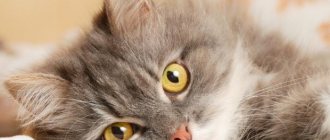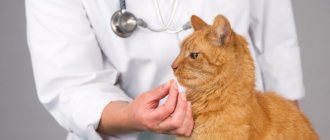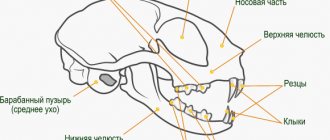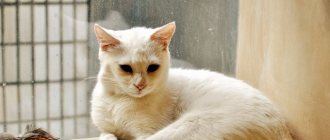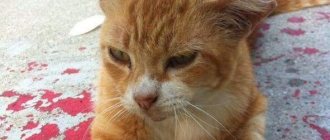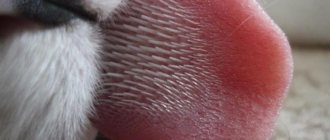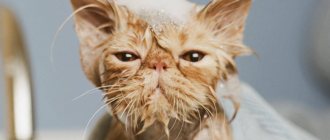Expecting kittens is always a very exciting stage for both the cat and the owner. Pregnancy in cats is different from that in women. In animals, childbirth takes place at the level of natural instincts and has a number of features. During this period, the cat needs to be provided with special care and know the finer points. In the article we will describe the stages of a cat’s pregnancy, the features of bearing kittens, and possible complications during this period. You will also learn how to organize care for a pregnant cat, tips for comfortable conditions during childbirth and after.
Onset and duration of pregnancy
A pet can become pregnant immediately after the onset of the first heat - at 7-8 months. At this age, the body is formed for fertilization, but is not yet ready for safe bearing of offspring. Because of this, mating is carried out only on the third heat.
Formally, ovulation occurs 24-30 hours after mating. For convenience, breeders calculate the total cycle length as the difference between the day of birth and the day of mating. On average, gestation of kittens lasts 62-68 days. The longest period is typical for the Siamese-Oriental group. These cats have offspring only 71 days after mating.
Symptoms of pyometra
It is almost impossible to determine pyometra in the initial stages. Symptoms of pyometra begin to manifest themselves three to four weeks after the end of estrus, or almost immediately after lambing.
There are two types of disease:
With an open cervix - at a late stage, purulent discharge with an unpleasant odor is noted. There is frequent licking of the genitals. The cat becomes lethargic, there is an elevated temperature, the cat eats and drinks little.
This form is considered mild and favorable for the animal due to the fact that the owner can pay attention to the symptoms in time and take the necessary measures for treatment.
With a closed cervix, the disease is more severe. This is due to the fact that due to the closed cervix, pus accumulates in the cavity.
Within a few days, the uterus increases in size, and there is a risk of rupture and peritonitis.
With this form the following symptoms are noted:
- The abdomen is many times enlarged in size, painful during palpation;
- Lethargy, loss of appetite;
- Heat;
- The animal drinks a lot of water;
- Frequent urination;
- Nausea, vomiting.
Lethargy with nausea are mistaken for symptoms of poisoning and a virus. Such misconceptions are dangerous because they take away valuable time for treating a cat.
Pyometra can also occur in pregnant cats. In this case, only surgical treatment is indicated. The offspring in such cases are not viable, but the cat can still be saved.
Seizures in cats - main causes, symptoms, first aid, treatment and choice of drugs (110 photos)Polycystic kidney disease in cats - causes, diagnosis and symptoms of the disease. Treatment options and prevention of kidney disease (95 photos)
Tartar in cats - signs of the disease and methods of fully treating tartar (125 photos + video)
How to spot pregnancy symptoms in a cat
Behavioral and physiological signs that a cat is pregnant appear soon after mating. Despite this, examination at a veterinary clinic is considered the most accurate diagnosis.
Early on
The first symptoms are increased drowsiness and decreased appetite. Active pets become lethargic and refuse to eat due to nausea. It is also possible for an early cessation of estrus and a change in pigmentation of the nipples to a more intense shade.
All these changes do not give a 100% guarantee and manifest themselves individually. If your pet does not eat for more than a day due to frequent bouts of vomiting, consult a doctor. This condition is not typical for a pregnant animal and indicates the presence of a disease.
At the veterinary clinic
If you know how to determine a cat’s pregnancy in the early stages, then do not be guided only by your own conclusions. In addition to the small guarantee of the symptoms seen, there remains the possibility of false pregnancy, which threatens the health of the animal. To confirm or refute this diagnosis, you must contact your veterinarian.
Make an appointment at the veterinary clinic for 20-25 days after mating. By this time, the placenta releases relaxin into the blood - a hormone that confirms the successful fertilization of the egg and is an analogue of human chorionic gonadotropin (hCG hormone). With cystic formations in the ovaries, the result may be false positive.
In addition to taking tests, the veterinarian performs an external examination and palpation of the animal. An ultrasound is performed to detect the fetuses, and an x-ray is used to determine their exact number and position. An X-ray is recognized as the most accurate diagnostic method, but is carried out no earlier than 50 days after mating.
At home
You can determine if a cat is pregnant at home by both behavioral and physiological signs. Unlike symptoms, which appear early, signs are a group of factors characteristic of a particular condition. That is, the appearance of certain symptoms is not always associated with successful conception and may indicate a disease.
The first signs of pregnancy in a cat appear on the 28th day after mating. The expectant mother's belly becomes rounder, her nipples swell, and her weight increases. The kittens begin to move inside the rounded belly. They can be felt by palpation, but veterinarians recommend avoiding this diagnostic method. Applying too much pressure can cause miscarriage, so leave palpation to an experienced veterinarian.
How the procedure itself is carried out
There is a photo of an ultrasound of a pregnant cat in the article, but the whole story cannot be understood from the image alone.
The procedure does not cause pain or harm to the cat itself and its future offspring, but the specialist may suffer. It is for this reason that the owner must be present at the study to help hold the pet and, if necessary, pacify it.
- First of all, the animal is placed on a disposable diaper with its belly up. This is where maximum help is needed; it is rare that a cat will lie quietly in this position.
- The veterinarian shaves off a section of fur. If the animal was brought already prepared, then the examination site is lubricated with a special gel.
- The veterinarian runs a device over the cat’s abdomen, performs the procedure, and reports the results to the owner.
- The gel from the animal’s belly is carefully removed using special cleansing wipes. This stage must be monitored especially carefully, because in the future the cat can lick off the remnants of the product, but it will definitely not be beneficial.
- If desired, the animal owner can receive a video recording from the study or a photo.
Accurate signs of cat pregnancy
An unsuccessful mating requires a repeat mating, and a successful conception requires careful monitoring of the expectant mother, helping to prevent the development of pathologies. Both situations require the owner to understand the exact signs that appear in a pregnant animal.
Termination of heat
Sometimes breeders charge for each mating with their pet. Knowing how to understand that a cat is pregnant after mating, you eliminate unnecessary repeated meetings with her partner and save money.
The premature end of estrus is accompanied by the disappearance of discharge and the return to the usual state of the genitals. The loop loses its intense color and swelling.
Abdominal rounding
Growing fruits stretch the uterus, increasing its size. Along with the internal organs, the stomach also increases. A month after conception, kittens begin to move in it.
Swelling of the nipples
The changes occurring in the mammary glands are difficult to miss. The nipples change color to a more intense one and gradually swell. A week before giving birth, they turn bright pink and begin to secrete colostrum, a special liquid rich in proteins and fats.
Behavioral signs
Changes in hormonal levels are accompanied by a loss of activity and interest in games. This change is difficult to track if the pet has always liked to sleep alone. The opposite situation is also acceptable, when a phlegmatic and unsociable person becomes playful and affectionate. In rare cases, aggression may occur. This behavior is typical for hairless breeds.
Animals suffer from toxicosis just like people. Because of this, a pregnant pet's taste preferences may change. In this case, she will refuse her favorite treats in favor of her least favorite foods.
The most striking sign appears shortly before birth. The pet begins to look for a convenient place and set up a “nest”. Veterinarians recommend helping her with this to avoid choosing an inappropriate location.
Causes of pyometra in cats
The cat's uterus has two horns that connect into a short body. Adjacent to it is the cervix, which passes into the vaginal vault.
The wall of a cat's uterus consists of mucous, muscular and serous layers.
In the mucous membrane of the uterus or endometrium there are special cells that secrete a secretion that protects the mucous membrane of the genital tract from the action of various pathological factors. The amount of secretion depends on the stage of the reproductive cycle; for example, less is secreted between heats. The secretion moves towards the vagina due to contraction of the uterine wall. Normally, the uterine cavity should not contain free fluid, with the exception of membranes during pregnancy.
The development of pyometra in a cat can be influenced by several interrelated reasons:
1. Opportunistic microflora: streptococci, staphylococci, E. coli and other microorganisms that enter the uterine cavity through the cervix from the vagina. The cervix opens partially before and during ovulation. This causes purulent inflammation of the uterine mucosa or purulent endometritis. In this case, the lumen of the cervix narrows sharply due to thickening of the mucous membrane. As a result, the removal of inflammatory effusion is impaired. The contents fill the uterus, sometimes significantly increasing the volume of the organ.
2. Changes in the mucous membrane:
- purulent endometritis, as a result of the action of various pathological factors
- acute postpartum endometritis
- endometritis as a consequence of abortion. Abortion in an animal is an interruption of pregnancy in which the embryo is completely or partially resorbed in the uterus, or the fetus is expelled from the uterus. Sometimes the fruit may decompose.
- endometritis, as a result of hormonal changes. Normally, after the release of a mature egg from the ovary (ovulation), female sex hormones are produced that prepare the endometrium for pregnancy. In the absence of pregnancy, the effect of high doses of sex hormones leads to changes in the endometrium. Hormonal imbalances may result from disruption of internal organs or from the use of drugs that stop ovulation.
3. Other reasons:
- pathological birth
- incorrect assistance during childbirth
- atony (lack of tone) or hypotension (decreased tone) of the uterine wall
- infectious and invasive diseases
- previous illnesses
- scars, fusion of the cervical canal
- pelvic bone injuries
- malignant neoplasms that cover the cervix and are a source of bacteria during tumor decay
First pregnancy
Young animals are bred at approximately 1.5 years. This reduces the risk of miscarriages and the birth of kittens with serious pathologies. If your furry pet becomes pregnant for the first time, then all the symptoms are more pronounced.
The safety of mating decreases after 6 years. At this age, breeding animals are sterilized. If you do not plan to breed the breed, sterilize your pet immediately after reaching maturity. This will reduce the risk of developing cancer to 0.5%.
Indications for research
The negative impact of ultrasound of a pregnant cat on her health and the health of her offspring has not been proven, and many veterinarians advise performing this procedure. But, despite this, it is still not worth abusing the study without special indications.
An ultrasound examination should only be performed if the animal’s condition causes concern to the veterinarian.
A pregnant cat undergoes an ultrasound if necessary. Indications for the procedure include:
- the cat has chronic diseases;
- first pregnancy;
- disruption of the work of any organ;
- the age of the animal is more than 5 years and less than 1.5 years;
- difficult pregnancy;
- pathologies in the cat itself or in its partner;
- There were already complications during a previous pregnancy or childbirth.
False pregnancy
Pseudopregnancy is a phenomenon accompanied by precise signs of conception without actual fertilization of the egg. This condition occurs due to hormonal imbalances and severe stress, and is also inherited. The risk group includes Orientals, Sphynxes, Devon and Cornish Rex cats.
Felinologists suggest that this phenomenon is natural and was obtained during evolution. Thanks to pseudopregnancy, nulliparous individuals fed the offspring of the dead animal. One of the reasons for the appearance of false conception is the proximity of a pregnant four-legged neighbor.
How to distinguish a false pregnancy from a real one
As a rule, the only way to find out whether your cat has a false pregnancy is to consult a veterinarian. Self-diagnosis is not informative due to the abundance of characteristic external signs.
In case of false pregnancy, the blood test for relaxin will be negative. The diagnosis will be confirmed if there are no fetuses on x-ray and ultrasound.
If you do not rush for an examination, you may notice the disappearance of symptoms without a trace after some time. Veterinarians do not recommend ignoring diagnosis in a veterinary clinic, since false pregnancy is not always safe.
What is the danger of false pregnancy?
Frequent false pregnancies have a negative impact on the physical and mental health of the pet, increasing the likelihood of developing oncology, endometritis, mastitis, pyometra and other diseases. If hormonal treatment is ineffective, the animal is sterilized.
Ultrasound of the abdominal cavity of a cat includes examination of the condition of such internal organs as:
- Pancreas
- Liver
- Spleen
- Kidneys
- Intestines and stomach
- Bladder
- Reproductive organs
When performing an abdominal ultrasound in our clinic for a cat, the price will be 1,600 rubles. Examination of this list of organs can reveal a number of diseases that cannot be detected with the naked eye. When examining the pelvic and abdominal cavities, you can detect compactions, neoplasms, stones in the kidneys and bladder, cysts in organs (including cystic lesions of the uterus), which will allow timely treatment to begin and prevent their further development.
Caring for the expectant mother
Bearing offspring takes a lot of energy, so the pet needs help from its owner. Pay attention to nutrition and living conditions, and don’t forget to build a safe “nest” for the upcoming birth.
Diet and vitamins
In the first days of the appearance of increased appetite, the usual feeding rates are increased by 10%. In addition to the quantity of food, it is important to take care of its quality. To give birth to healthy offspring, your pet will need more vitamins and minerals. They can be obtained from super-premium and holistic-grade dry foods designed specifically for pregnant animals.
To change your eating habits you will need:
- Switch to easily digestible meals or special food. In the first case, the addition of vitamin and mineral supplements is mandatory, and in the second, it is discussed individually. Ask your veterinarian for exact dosages and brands.
- Increase the frequency of feedings. Do not try to feed an increased amount of food in 2 meals. Have 5-6 feedings per day. With the beginning of the second trimester, the amount of food should be increased by 2 times compared to the original.
- Change the water regularly. Do not forget to monitor the cleanliness and amount of liquid. Its deficiency or contamination with bacteria can lead to miscarriages.
Do not try to buy vitamins on the advice of friends and acquaintances. This is fraught with hypo- or vitamin deficiency.
Setting up a place for childbirth
When choosing a place for a “nest” on their own, animals often huddle under the sofa, preventing the owner from helping during difficult childbirth. Eliminate such a turn by applying your own strength. Find a safe place on a horizontal and low surface and place there:
- a large box that can accommodate not only the expectant mother, but also her kittens;
- soft bedding and a disposable diaper to protect against leaks;
- tray, bowls for food and water.
Accustom your pet to the constructed “nest” from the first days of confirming its position. Soon she will start carrying soft toys there and spending most of her time there.
Other nuances
Protect your pet from drafts and overheating. Ventilate the room regularly. In later stages, help her with genital hygiene. Licking will be difficult due to the enlarged belly.
Prevent jumping onto high objects. Any injury can harm the health of kittens, so it is better to replace high play sets with floor-mounted scratching posts.
Nutrition for a pregnant cat
A pregnant cat should receive high-quality and complete food. And if the animal is accustomed to eating dry food, then buy food intended for feeding such animals.
If you feed your pet natural food, which is preferable, then after consultation with a veterinarian, add a vitamin and mineral complex to the diet.
While on natural feeding, the cat should receive the following products:
- lean meat: chicken, beef, turkey;
- porridge, they can make up up to 30% of the diet;
- fermented milk products once a day;
- vegetables;
- offal occasionally;
- eggs.
For about two weeks the animal is fed 2 times a day. And later they switch to three meals a day with increasing portions.
Later, the kittens begin to grow actively and the cat develops a voracious appetite. But she cannot eat very much at one time, so she needs to switch to eating 4-5 times a day.
Is it possible to terminate a pregnancy?
Abortion has a negative impact on the reproductive function and health of the animal. Veterinarians recommend avoiding it. The least consequences are typical for surgical abortion with sterilization. It is carried out in the first 6 weeks after conception, but it is safer to do it in the first 2-3 weeks. During the operation, the animal's uterus and ovaries are removed.
Prescribing abortifacients on your own is dangerous, so always seek help from a veterinarian. In the presence of serious pathology, a natural abortion occurs, that is, the fetuses die on their own inside the womb. In this case, the veterinarian must ensure that all kittens have left the uterus.
Possible pathologies
A healthy animal tolerates pregnancy and childbirth well. But there are problems with the physiology of the cat itself, which prevents it from bearing kittens normally. During pregnancy, all organs of the animal experience stress, and in addition to the future babies, the liver, kidneys, heart, lungs and intestines of the expectant mother are examined by ultrasound.
During cat pregnancy, the following pathologies can be observed, which threaten not only the life of the offspring, but also the cat:
- Uterine hernia in the groin area.
- Placental abruption is clearly visible on ultrasound. If measures are not taken in time, the cat will begin to uterine bleeding, which threatens its life.
- Polyhydramnios - noticeable in recent weeks.
- If the animal has fallen or jumped from a height for a decent period of time, then an ultrasound is simply necessary to exclude possible torsion of the uterus.
- Intrauterine fetal death. Unfortunately, many purebred cats cannot expel dead fetuses from the uterus on their own, and the rotting mass in utero can kill the cat. If you notice something wrong in the behavior or condition of the animal, urgently take it to the veterinarian for an ultrasound.
